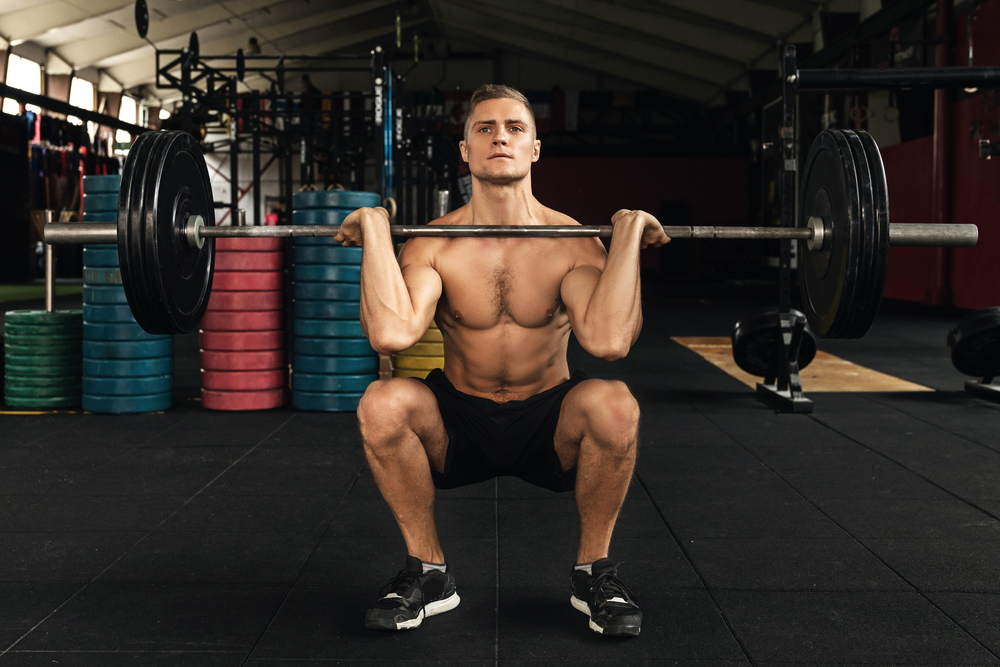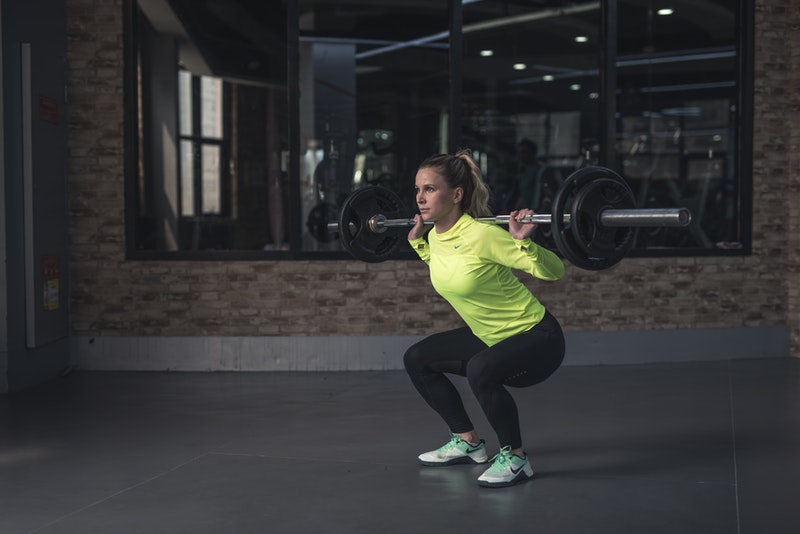Front and back squats allow for training with very high loads – but which is safer? No exercise is 100% risk free.
This article will examine the risks in both types of squat, along with some considerations to maximise safety.
Are Front Squats Safer Than Back Squats?
Both types of squat are safe when performed correctly, with appropriate precautions taken in your gym set-up. The biggest risk in both lifts is to miss in an unsafe fashion.

Reasons why front squats can be safer
Shoulder troubles
While the majority of people will find it easier to rack a bar onto their back than their collar bone, using a straight bar can be tough on the shoulders.
In terms of safety, this is more like a slow burn – the back squat beats up your shoulders, which leads to pain in benching, which leads to an eventual injury somewhere further down the line.
Monitor your flexibility. If you are finding you need to move your grip out wider in the squat because of pain, that could be a red flag.
Lower systemic loads
You can always move more weight on the back than the front.
For someone whose primary focus isn’t pushing the boundaries of absolute strength, there is less load being put onto the body.
Always use the minimum effective dose for what you’re trying to achieve.
Less risk of ego lifting
The precision, balance, pain and difficulty involved in a heavy front squat are a deterrent to someone overloading the movement.
The front squat might represent a safer choice for someone who is easily carried away with load selection.
(Of course, in order to make this choice you would need the self-awareness to not be ego lifting in the first place…)
Reasons why back squats can be safer
AC joint separation
If you have an AC (acromioclavicular) joint separation, the front squat may be contraindicated. Check with a medical professional on that one.
Knee pathology
The trouble with chronic knee pathologies is that surgery has a very low success rate.
Often, the only option for someone with structural damage is to endure and manage it.
If you suffer from structural damage that isn’t going away, that doesn’t mean squatting is off the table.
The increased knee angles of the front squat may be irritant to the injury.
It may make more sense to retire the front squat. With the bar on the back, you can adopt a more posterior dominant, hips back style, possibly with a wider stance.
This change in angles, in combination with cutting depth at just below parallel, can reduce the knee bend to just over 90º. This may be enough to continue squatting without exacerbating the injury.
Safety Considerations When Performing Front Squats
The elbow must not touch the knee
During the front squat, the elbows must remain high and in line with the shoulders.
A dropping of the elbows creates a risk of contact with the upper thighs.
If the elbow meets the leg, the forearm is sandwiched. The compressive forces here can break bones.
I have met two novices who have broken their wrists in this way.
They were training the clean (where the bar travels from the floor to the rack found in the front squat) in a fatigued state.
In a heavy front squat miss, I once glanced my elbow briefly on my thigh.
The resulting wrist sprain took more than 8 months to heal.
Space between the lifter and the rack/stands
You might think that front squats get missed in the bottom, but it’s more common to miss when you’re out of the hole and almost to the top.
When this happens, your bar is going down very fast.
Ideally, you will be using bumper plates, and there will be a wide gap between you and your rack/squat stands.
If there’s not, the bar can roll, and rebound off a fixed rack. This will hurt your shins.
If the squat stands are loose, they can get knocked over and crash into you or other people nearby.
Make sure there’s enough space between you and the rack for the bar to crash down without hitting anything else.
Because you can easily miss a front squat from high up, I wouldn’t recommend performing the movement inside a squat rack with safety pins.
You could end up wrapping your bar around the pins and bending it.
Missing backwards – further wrist break potential
This is rare, but it’s happened to me and I’ve seen it happen to others.
If you find yourself in a situation where you have lost your balance and are falling backwards in a front squat, you need to take decisive action.
Keep the elbows high as you fall, and turn your head to the side.
If you are fortunate, you will land on your back with the bar landing harmlessly above your face.
If you lower your elbows, you can sandwich the forearm between the floor and the bar. This could result in two broken wrists.
Safety Considerations When Performing Back Squats
Torso angle and missing
If your proportions allow for a fairly upright, weightlifting style squat, you may be fine with missing the bar behind you.
If your squat has more forward lean, it might not be possible to clear the hips from under the bar in time.
If you’re the kind of lifter who misses forwards, be judicious in your use of spotters or safety pins.
Set your safety pins up correctly
You don’t want to set your safety pins too high, because it can be very jarring on the spine to crash into them.
Once you get to a certain strength level, your bar will bend and whip more as the weights go up. You could test an empty bar and it seems fine, but then find the bar hits the pins at heavier weights.
Leave yourself a good couple of inches to account for bar bend and changes in torso angle as the weights get heavier.
It should be obvious, but setting your safety pins way too low is the same as them not being there.
Spotter considerations
A spotter who doesn’t know what they are doing can mess up your back. Either they leave you for dead, or one will lift at a faster rate than the other, causing a twist.
Favour a side spot with two people over a rear spot.
Make sure everyone is on the same page. If you’re in a gym where you don’t know or trust anyone, don’t grab a spot from randos. Stay inside the rack for safety.
On the flip side of this arrangement, don’t leave your spotters for dead either. If you’ve missed the squat, don’t go limp. You can hurt them. Keep squatting and allow them to help you get the bar back into the rack.
Years ago, a friend of mine dumped 170kg on me and I still give him shit about it to this day. I applaud his trust in me that I can catch 170kg in my hands cold. But still…
Don’t be that guy.

Are Front Squats Safer For Your Lower Back?
If you read around, you’ll see plenty of people recommending that front squats are safer for the lower back, owing to the upright torso angle.
The thinking here is that the higher shear forces can be injurious to the lower back.
In practice, I’ve not seen many lower back injuries in either lift over the years.
Anecdotally, I can only recall one lower back injury in my own lifting.
This was from front squatting as a novice, in my first month of training.
If you are curling your torso under at the bottom of any squat (extreme butt wink) you can be at risk of spondylolisthesis, where the vertebrae shift and partially separate.
Having a spondylolisthesis doesn’t mean you need to give up squatting, but you will need to take care to ensure your alignment is right every single rep.
Short answer: all squats make your lower back stronger, which is protective in itself. Front and back squats seem to carry equal levels of safety for the lower back, when performed correctly.
That’s all for this article, but why do you get a lump on your back from squats?
Hope this helped!
Sources
I’ve been in the fitness and strength training industry for nearly a decade. In that time, I’ve gained 30 pounds of muscle, written hundreds of articles, and reviewed dozens of fitness supplements. As for my educational background, I’m a currently studying for my Active IQ Level 3 Diploma in Personal Training.

